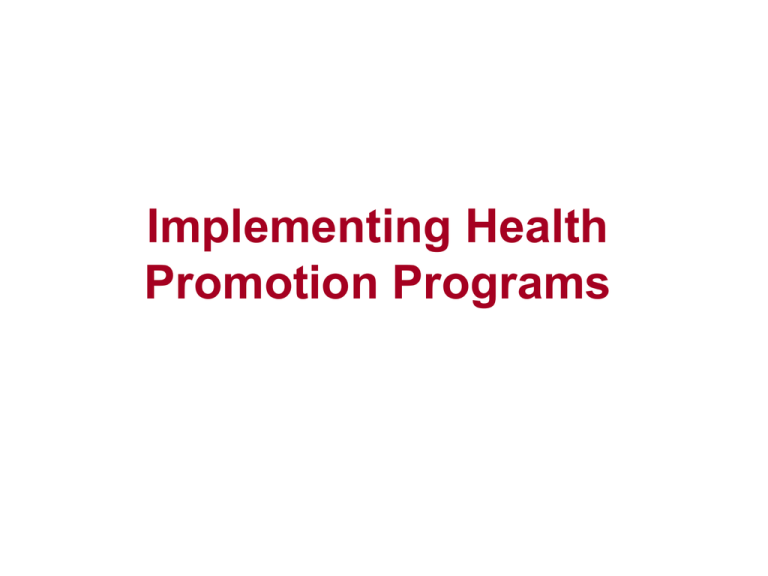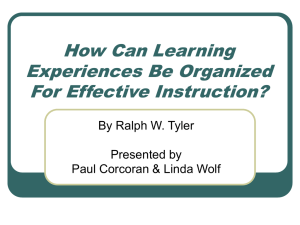Implementing health promotion programs part 3
advertisement

Implementing Health Promotion Programs Implementing Health Promotion Programs • Community Organizing and Community Building • Identification and Allocation of Resources • Marketing: Making sure programs Respond to Wants and Needs of Consumers • Implementation: Strategies and Associated Concerns Community Organizing and Community Building • Community defined – Membership – a sense of identity and belonging – Common symbols systems – similar language – Shared values and norms – Mutual influence – influence each others – Shared needs and commitment to meeting them – Share emotional connection – common history, experiences, and mutual support Community Organizing and Community Building • Community Organizing – A shift from individuals to broader community involving citizen participation, grass-roots participation, community participation, macro practice, community based, community empowerment, and community partnerships – Defined: a process through which communities are helped to identify common problems or goals, mobilize resources, and in other ways develop and implement strategies for reaching their goals they have collectively set (Minkler, 1997, p. 5) Terms Associated with Community Organizing • Citizen Participation – The bottom-up, grass-roots mobilization of citizens fro the purpose of undertaking activities to improve the condition of something in the community • Community Capacity – Community characteristics affecting its ability to identify, mobilize, and address problems Terms Associated with Community Organizing • Community Development – A process designed to create conditions of economic and social progress for the whole community with its active participation and the fullest possible reliance on the community’s initiative (United Nations, 1955, p. 6) • Community participation – A process of involving people in the institutions or decisions that affect their lives Terms Associated with Community Organizing • Empowered Community – One in which individuals and organizations apply their skills and resources in collective efforts to meet their respective needs • Grass-Roots Participation – Bottom-up efforts of people taking collective actions on their own behalf, and their involve the use of a sophisticated blend of confrontation and cooperation in order to achieve their ends • Macro Practice – The methods of professional change that deal with issues beyond the individual, family, and small group level. Steps in Community Organizing and Building 1. Recognizing the issue: recognizes that an issue exists in the community and that something needs to be done about it 2. Gaining entry into the community 3. Organizing people 4. Obtaining the support of the community members to deal with the concern 5. Assessing the community Steps in Community Organizing and Building 6 Determining the priorities and setting goals 7 Arriving at a solution and selecting intervention strategies 8 Implementing the plan 9 Evaluating the outcomes of the plan of action 10 Maintaining the outcomes in the community 11 Looping back Planned Approach to Community Health A Five Phases of PACH Model for Community Organization Process 1 Mobilizing the community 5 Evaluating PATCH Source: Kreuter et al. (1985) 2 Collecting and organizing data 3 Choosing health priorities 4 Developing a comprehensive intervention plan Identification and Allocation of Resources • Resource defined: Including all the people and things needed to carry out the desired program – Personnel, internal resources, external resources, combined resources, space, equipment and supplies, financial resources, participant fee, third-party support, cost sharing, organizational sponsorship, grants and gifts The Components of a Grant Proposal • Title (or cover) page: concise and explicit • Abstract: short and concise • Introduction: begin with a capsule statement, be comprehensible to the informed layperson, including problem, significance of the program, and purpose of the program. • Background: Previous work and the related literature The Components of a Grant Proposal • Description of proposed program: include the objectives, description of intervention, evaluation plan, and time frame • Description of relevant institutional/agency resources: identify the resources the proposer’s organization will bring to the project • List of references • Personnel section • Budget: include budget needs for personnel, equipment, materials, and supplies, travel, services, other needed items, and indirect costs Marketing: Making sure Programs Respond to Wants and Needs of Consumers • Market defined: the set of all people who have an actual or potential interest in the product or service • Marketing: the planned attempt to influence the characteristics of voluntary exchange transactions – exchanges of costs and benefits by buyers and seller or providers and consumers. • Apply to health promotion: Suggesting that planners would like to exchange costs and benefits with those in the priority population. – i.e., planners would like to exchange the benefits of participation in health promotion programs (the objectives or outcomes of the programs they panned), such as “a longer healthier life, looking and feeling better, and having fewer but healthier children for the costs of the program, which may come from the participants. Diffusion Theory (Rogers, 1962) The theory provides an explanation of the diffusion of innovations (something new) in populations, stated in another way, it provides an explanation for the pattern of adoption of the innovations If one thinks of a health promotion program as an innovation, the theory describes a pattern the priority population will follow in adopting the program. The pattern of adoption can be represented by the normal bell-shaped curve. The theory provides an explanation of the diffusion of innovations (something new) in populations, stated in another way, it provides an explanation for the pattern of adoption of the innovations Innovators Early adopters <3% 14% -2sd -1sd Late majority 34% Mean Number adopting -3sd Early majority 34% Time +1sd Laggards 16% +2sd +3sd Diffusion Theory • Innovators: 2%-3% of the priority population would probably become involved in the program just because they had heard about it and wanted to be first • Early adopters: -1 SD, 14%. Very interested in the innovation, but they are not the first to sign up. • Early majority and late majority: fall between minus 1 sd and the mean, and between eh mean and plus 1 sd. 34%. Those in the earlier majority may be interested in the health promotion program, but they will need external motivation to become involved. Those the early majority will deliberate for some tie before making a decision. It will take more work to get the late majority involved, because they are skeptical and will not adopt an innovation until most people in the social system have done so. • Laggards: 16%. Greater than plus 1 sd. Not very interested in innovation and would be the last to become involved in the health promotion programs, if at all. The Marketing Process and Health Promotion Programs • Five distinct functions of the marketing process as they related to the health care field (Syre and Wilson, 1990). – Using marketing research to determine the needs and desires of the present and prospective clients from the priority population – Developing a product that satisfies the needs and desires for the clients – Developing informative and persuasive communication flows between those offering the program and the clients – Ensuring that the product is provided in the appropriate form, at the right time and place, and at the best price – Keeping the clients satisfied and loyal after the exchange has taken place Implementation: Strategies and Associated Concerns • Implementation defined: the act of converting planning, goals, and objectives into action through administrative structure, management activities, policies, procedures, and regulations, and organizational action of new program (Timmreck, 1997, p. 328). Phases of Program Implementation • Phase 1: Adoption of the Program: greater care must go into the marketing process to ensure that a relevant product (i.e., the health promotion program) is planned so that those in the priority population will want to participate in it. • Phase 2: Identifying and Prioritizing the Tasks to be completed. Many of these tasks are often referred to as program logistics, defined as the procurement, maintenance, and transportation of materials, facilities, and personnel A Task Development Time Line Year 1 Develop program rationale Conduct needs assessment Develop goals And objectives Create intervention Conduct formative evaluation Assemble necessary resources Market program Pilot test program Refine program Phase 1 intervention J F M A M J J A S O N D A Task Development Time Line (cont.) Year 2 Phase 2 intervention Phase 3 intervention Phase 4 intervention Total implementation Collect and analyze data Prepare evaluation report Distribute report Continue with follow-up for long-term evaluation J F M A M J J A S O N D Phases of Program Implementation • Phase 3: Establishing a System of Management: Turn attention to how the program will be managed. Defined as the process of achieving results through controlling human, financial, and technical resources (Breckon, 1997, p. 313) • Phase 4: Putting the Plan into Action. Many ways: by using a piloting process; by phasing it in, in small segments, and by initiating the total program all at once. They are better explained by using an inverted triangle (see next slide). Disadvantages Advantages - More people involved - Evaluation more meaningful With larger group Total Program - Easier to copy with workload - Gradual investment Phase-in - Opportunity to test program - Close control of program Pilot - Big commitment - No chance to test program Fewer people involved - Very few involved - Not meeting all needs - Hard to generalize about results Phases of Program Implementation • Phase 5: Ending or Sustaining a Program: determine how long to run a program. – End, if the objective is reached. – Continue, if the goal and objective is not met Concerns Associated with Implementation • Legal Concerns: Liability. – Make sure to adequate assess the risk (physical, mental) – Informed consent – Confidentiality • • • • • • • Medical Concerns: need medical clearance Program Safety Moral and Ethical Concerns Procedural Manual and/or Participants’ Manual Training for Facilitators Dealing with Problems Reporting and Documenting SUMMARY • Five phases planners follow in implementing a program – Adoption of the program – Identifying the prioritizing the tasks to be completed – Establishing a system of management – Putting the plan into action – Ending or sustaining a program SUMMARY • There are matters that need to be considered and planned for prior to and during implementation









